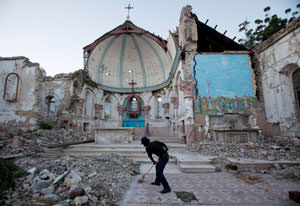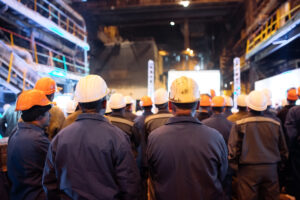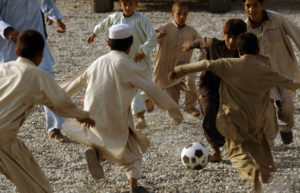Quelle Surprise! Haiti on the Mend
In Haiti there is nothing more unexpected than good news.
In Haiti there is nothing more unexpected than good news. After an absence of a dozen years, I returned to a country from which I had reported regularly for more than a decade to visit old friends and get reacquainted. In the 1980s and early 1990s, I was one of the leading journalists in Haiti covering almost every event, election, coup, riot and anything else that happened for the Chicago Tribune. Since I left, there had been a military coup d’etat reversed by a U.S. military invasion; the emergence of gang warfare, street crimes and kidnappings; and a devastating earthquake. What could be left of poor suffering Haiti?
The first thing I noticed was a new modern airport. The Haitian government had also rebuilt some of the shaky bridges over dry ravines that become wild roiling rivers when the afternoon rains come. Schools were being built. This was something new for Haiti, a government supporting real development projects that actually improved things.
When I was last in Haiti I knew the man who is now president, a rocker then who wore trendy clothes, a shaved head and spoke in a hip way with American slang in his Creole. He had right-wing politics, ties to the brutal military and had adopted the nickname Sweet Mickey from a feared army colonel Michel “Mickey” François.
Sweet Mickey Martelly, who sang in a sweet voice songs with biting, sometimes off-color lyrics, has for the past two years been President Michel Martelly and wears conservative business suits. He opposed his predecessor Rene Preval and his predecessor Jean-Bertrand Aristide who was overthrown in a 2004 coup d’etat that Martelly supported. But this makes Martelly, however dubious his credentials, the first president in Haitian history to peacefully take power in an election from a predecessor of an opposing party. Martelly’s critics point out that he inherited most of his development projects from Preval rather than originating his own plans, but a president who continues rather than discards the programs of the opposition is something that is also very new for Haiti.
There are roads being built and Haiti will soon have a better street system than it has ever known. The Ecuadoreans have built roads in the Artibonite, the farm belt in the center of the country where there had never been roads before. Private companies from the neighboring Dominican Republic, a country with which Haitians share an island but so few relations that at times you could not even cross from one nation to the other, have been building streets, including one to Jeremie, an isolated community in the far south that has never before had such a connection.
The opposition claims that President Martelly took kickbacks for granting the Dominicans no-bid contracts. The opposition also faces corruption charges it hasn’t answered. How is it that Aristide, who was a penniless parish priest when I left, now lives in a huge mansion that he built for himself? How enormous is hard to say since the walls around it are rebuilt ever higher.
Three years ago, on Jan. 12, 2010, an estimated 300,000 people were killed and about 2 million lost their homes when an earthquake struck crowded Port-au-Prince. International relief organizations placed 1.5 million homeless people in 1,555 tent cities throughout the capital in public squares or anywhere else that space could be found. Today, there are about 300,000 still in tents, mostly on the outskirts of the city. Parks and fields have been reclaimed. Place Boyer, a run-down plaza turned tent city, is now restored with decorative Haitian tiles and stunning tropical gardening.
Getting 1.2 million people out of camps that were sometimes disease and crime ridden seems a major accomplishment. But there are at least two sides to everything in Haiti. Human rights group Amnesty International claims that 65,000 people were forced to leave, which would still represent a small number of the people who exited.
But there are other problems. Most of the displaced people were not returned to the sites of their original homes. It was easier to build new neighborhoods than to clear the rubble and ruins of the old ones. But where in the increasingly crowded capital was the space for all these new houses? The only available areas were on mountain slopes seemingly too steep for construction. However, new communities of hundreds of cinder block houses have been built on 60-degree mountain inclines. There are no roads there, so people in the higher-up houses have to climb the steep peaks on foot to get home. And the houses were constructed with Haitian made cinder blocks that have never been stress tested; no one knows whether in time they will crumble.
Worse, many of these communities have been built with houses jammed next to one another and no trees. The lack of greenery on the mountains is a serious problem throughout Haiti. The trees have been chopped down to sell as charcoal or for construction; without trees there are mudslides and erosion. The scars of such events can be seen on many mountainsides. Afternoon rains in Port-au- Prince turn into floods. The day after I left, the streets were transformed into muddy rushing rivers several feet deep, paralyzing the city. It seems certain that eventually some of these new communities will be lost in landslides, but there are so many tragedies waiting to happen that Haitians expect them with a stoic fatalism. No one knows exactly how many people live in Haiti. When I was last there the standard estimate was about 6.5 million, but now the World Bank is saying the population is more than 10 million. At any rate, it is visibly more crowded. Rural villages are now towns of twice their previous size. The traffic in Port-au-Prince is unbearable. A word in Creole has newly come into fashion — blokus — to describe a gridlock at major intersections that can hold traffic still for hours. The Haitians wait with little horn honking.
If nothing else moves a blokus, the Haitian police have a special American trained unit called the BIM, a Motorized Intervention Brigade, which steps in. Men with helmets, bulletproof vests and assault rifles clear up traffic jams very quickly. Assault rifles are new. When I was last in Haiti there were M-1 rifles and Uzis. But then again, this visit I sometimes saw a farmer plowing a field with a green John Deere tractor whereas when I was last there, there were only oxen and donkeys doing that work.
But of course these troops were created for more than traffic problems. The armed slum gangs that emerged to support Aristide when he was president outlasted him and have made the streets far more dangerous than they ever were when he was in power. At night, the pop of arms fire can be heard in the city echoing off the mountains. It is a familiar sound, but in past years the violence had been political, not criminal. Given Haitian history, political violence is still a possibility.
Jean-Claude Duvalier, the ousted scion of a despotic 29-year reign that held the nation in terror, has returned from exile, his stolen fortune gone. Ironically, the most legendary kleptocrat in modern Haitian history cannot live as luxuriously as Aristide, who was supposed to end corruption. Young people, who are the great majority of Haitians, do not remember the Duvaliers and talk of how the streets were cleaner and there was no crime when that family prevailed. But older Haitians remember the murderous state. Haiti was a silent country, people were afraid to speak and the corpses of the regime’s victims were dumped by the side of the highway. People are still afraid that Duvalier could come back to power. One family said it was not republishing a book by a deceased relative on Duvalier crimes because it was afraid of him. Given the rapid twists of Haitian politics, it is not inconceivable that Duvalier could someday retake office.
Haiti is now a democracy and people speak their minds, but they are careful. There is supposedly complete freedom of the press, but when I was last in Haiti there were a dozen newspapers and now there is only Le Nouvelliste, which publishes boosterish articles about the rebuilt Place Boyer or a new school. But in a country where only half the population can read, radio is far more important and there a variety of opposition views are aired.
Meanwhile, there are construction and development programs everywhere. Some are better appreciated than others. The Dominican Republic and Venezuela’s late President Hugo Chavez have earned praise. Bill Clinton’s foundation, for unclear reasons, is completing a huge high-rise business-class hotel, which has generated less enthusiasm. The United Nations has become a huge presence here with several bases. But its many trucks and SUVs contribute to the traffic problem. Although the U.N. came to help and to guarantee stability with troops, some of those troops brought cholera, which has killed 8,000 Haitians and, according to Doctors Without Borders, is still not under control. Some political groups opposing the U.N. have been calling for an end to the “occupation.”
Despite the infrastructure projects, the city destroyed by an earthquake has not been rebuilt. I cannot find my way around the center of a city whose every street I used to know. It is difficult to recognize roads without their buildings. In the center of town, the national palace is gone and the row of 200-year-old government buildings is missing, but to many people’s disappointment, a bizarre steel and concrete monument several stories high that the Haitians have dubbed “the tower of terror” remains standing. The commercial center is rubble, some streets still impassable. The buildings that housed shops are cracked and roofless and many of the businesses are in the street in front of the crumbled shells or piles of rubble. The cathedral looks like a scene from World War II Europe with a few elegant arches and pillars marking the spot where once stood a towering church.
In contrast with all the ruins, Preval redid the Duvalier family beach home into a public space, and for the first time, young Haitians have a place to go to the beach. Nearby, a new coastal resort, extremely modest by Caribbean standards, has opened and has been named Obama Beach Hotel. It’s a different Haiti from the one I knew before, and if there are no more mudslides, hurricanes or coup d’etats — all common occurrences in the country — it could at last be getting a little better.
Your support matters…Independent journalism is under threat and overshadowed by heavily funded mainstream media.
You can help level the playing field. Become a member.
Your tax-deductible contribution keeps us digging beneath the headlines to give you thought-provoking, investigative reporting and analysis that unearths what's really happening- without compromise.
Give today to support our courageous, independent journalists.





You need to be a supporter to comment.
There are currently no responses to this article.
Be the first to respond.